|

|
|
About the Apocalypse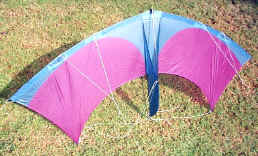
These plans are published with
the permission of Charlie M’Clary to share his design with amateur
builders. Besides appearance, the
Apocalypse is an unusual kite for having a drum-tight sail, a central
stabilizing keel and no straight spars. The sail tension is increased by
the perimeter leech lines and bowed spars that keep the entire sail
tight and responsive. Unlike other quad line kites, a central keel
provides directional stability. To aid assembly, storage and
transportation, the LE spars disconnect from the nose fitting for
disassembly, keeping the spars with connectors and bridle knots intact.
Openings for the LE fittings and slots for the bridle allow limited
movement of the spars. A Dacron and Velcro flap retains the nose
fitting. The kite is 33.25 inches (850 cm) high and 79.5 inches (201.9
cm) wide, weighing 6.4 ounces (182 grams).Charlie says it doesn't dead-launch
easily, but he seems to like how it tricks on slack lines.
Materials
Icarex polyester fabric is probably the best fabric for this kite
as stretchy would make adjustments a never-ending task. 3.9-ounce
Dacron reinforcements are sewn at stress points along the leading edge
inside the spar tunnels. The leading edge spars are wrapped, tapered
carbon with remaining spars standard carbon tubes and rod. A short
section of plain carbon spar is glued into the small ends of the LE
spars to accommodate the small nocks. The only non-standard fitting is
the nose assembly fashioned from a modified, dual line sport kite center
T-fitting.
Building notes
The example in the photos shows the excellent work of Pam Kirk and Mike Dennis of Heads Up Kites. Hems
and seams are quite narrow at around 0.25 inch (6 mm). The original
kites were made with single and double-row straight stitching, simple
lap seams and single-folded hems. Zigzags should suffice for the
homebuilder with a standard machine. Since the original plans are in
inches, I'll keep them that way for simplicity, and seam and hem
allowances are shown where needed. Edges marked “cut line” have no
allowances, and dotted lines represent stitches.
|
|
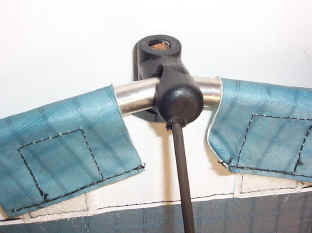 |
Rear of nose
The nose fitting drilled to accept a .125” carbon
rod. This holds a ferrule bent to the angle of the leading edge spars.
Velcro serves to fasten the Dacron flaps that allow easier disassembly.
Icarex PC covers the white flaps in the photo |
|
Rear of leading
edge
A standard APA sport kite leading
edge fitting and c-clip hold the .180” pultruded carbon vertical spar.
The Dacron-reinforced oval hole allows disassembly by sliding spar from
nose fitting. The vertical spars all arch away from the sail, leaving it
flat.
|
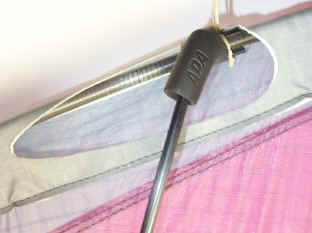
|
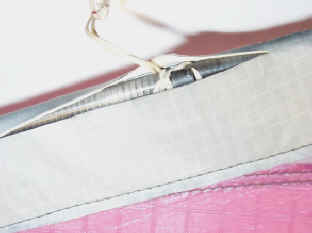 |
Rear of leading
edge
This is one of the upper bridle points that are
through a slot to allow movement of the SkyShark 3PT leading edge spar.
|
|
Rear of wingtip
Tiny folded strips of Dacron form
loops to tie tensioning lines for LE and leech lines. 75 pound Braided
Dacron line is used for all tension lines.
The FSD nocks have a side notch to
tie to. The leech line goes through the nock, back to the wingtip loop
and back to the nock to be tensioned and tied.
|
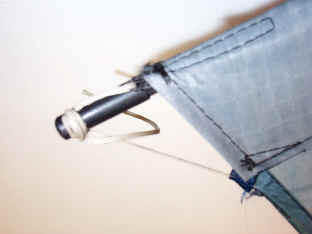
|
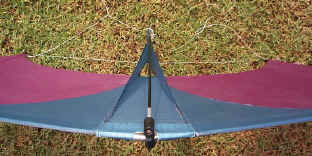 |
Looking
down the center front
The
.180” carbon keel spar is shown as it supports the keel. At its lower
end a .098 carbon rod is spliced to form the curve of the lower keel.
|
|
Center of
trailing edge
The intersection of the keel and
trailing edge is shown here. The black circular reinforcements are of
pressure sensitive ¾ ounce rip-stop tape applied prior to stitching.
|
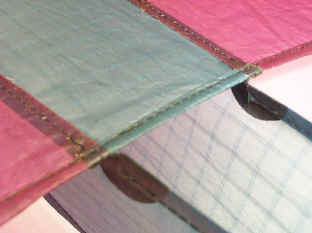
|
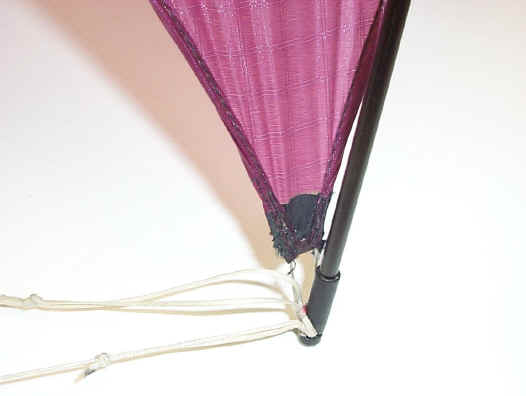 |
The lower end of
wing vertical spar
Here again the leech lines run through the nock, and
lower trick line and bridles lines attach to the wing spar nocks. |
|
The lower tip of
the keel
This is the connector at the keel tip where the
rear spar joins it at about 60 degrees.
The rear spar on the bottom has a sleeve to stop
it against the fitting, The fitting is actually a T-fitting for
drip irrigation tubing with two barbs removed. This could be
accomplished with .098 leading edge fittings such as those used on the
Prism Micron.
The lanyard to the fitting tensions the fabric.
|
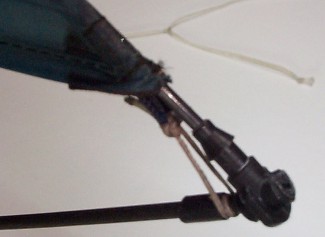
|
|
|
|
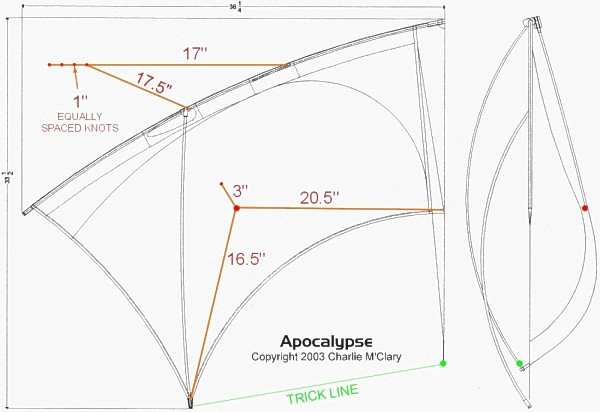
The bridle tow points can be made
with adjustable knots for lateral adjustment if desired.
|
|
Leading edge spars
(2) SkyShark 3PT 38.5" long
Wing vertical spar (2)
.180 carbon tubing 25.9 long
Upper keel
spar
(1) .180 carbon tubing 17" long
Lower keel
rod
(1) .098 carbon rod 17" exposed below upper keel spar
Rear center
rod
(1) .125 solid carbon rod 31.25" long
|
|
Apocalypse plan downloads
|
|
The template drawings are
downloadable in a zipped file that includes full-scale CDR, AI and DXF
drawing files.
Download
the drawing files
|
Template drawings are also
downloadable in a full-scale JPG file for builders without a drawing
program.
Download
the JPG file
|
| A JPG file showing an assembled
kite is available.
Download
this assembly file |
Feel free to ask questions. I
haven't made one yet, but plan to.
-Stan |